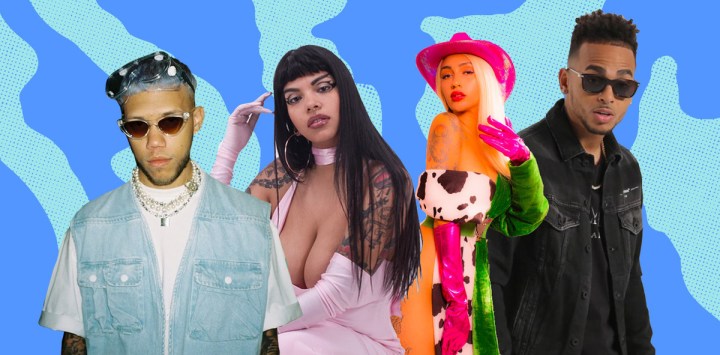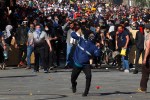Santiago de Chile Leads the World in Spotify Streams of Reggaeton

Art by Alan López for Remezcla
Based on Spotify streams, Santiago de Chile is the world capital of reggaeton. The news that the Chilean capital streams 400 million reggaeton tracks a month will surprise some riders of the global perreo wave — but probably not anyone who has been to SCL and is familiar with the genre’s history of being the dominant local sound.
A post published Wednesday on Spotify’s For The Record blog disclosed that Santiago accounts for an improbable 10 percent of the planet’s reggaeton streams on the service. The city’s “average reggaeton fan” (defined as listeners who play at least one reggaeton song a month) plays 126 tracks a month. A Spotify representative told Remezcla that in the month that the statistics were based off of, Santiago streamed 411,813,268 songs. This Tuesday alone, the 5.6 million person city listened to 18,469,963 reggaeton tracks.
Spotify streams aren’t the final word when it comes to industry metrics — everyone knows that reggaeton lives for racking up Youtube views. But the news is still shocking. Santiago streams twice as much reggaeton as second runner-up Mexico City, even though CDMX is home to nearly twice as many people as the Chilean capital.
“It doesn’t surprise me,” says trap and reggaeton artist Jamez Manuel. “For a long time, people here have listened to a lot of música urbana, primarily from the United States, but also from Puerto Rico. Puerto Rican artists have come here on tour since ‘Gasolina’ was big.”

Manuel is a Santiago-born artist who has been working with reggaeton sounds as far back as 2007, when his group Zonora Point dropped its first two mixtapes Masturbación en Familia Vol. 1 and Xprez Vol. 2. Around that time duo began working with Hugo Douster, the French producer who would later be known as King Doudou and whose tropical sound would help define the work of next wave reggaeton artists like Ms Nina.
In the mid 2000s, Santiago gave birth to the upstart Pokemones movement (which itself had its roots in the skater-oriented “harcoritos” of Santiago’s peripheral neighborhoods). The emo aesthetic Pokemones cut their hair in anime-like otaku style — hence their moniker — and got together at massive inner city perreos that thrived on the rhythms of Héctor y Tito’s “Baila Morena” and Don Omar’s “Dale Don Dale.”
Regarding the popularity of these Puerto Rican artists, Manuel sees reggaeton’s popularity of evidence that his country has always been an early adaptor of US culture. “I think it might be because we’re the most gringo country in South America,” he says. “Definitely, reggaeton hit harder here than in other places.”

Generations later, the country has birthed its own distinctive reggaeton aesthetic. Manuel is a member of Tomasa del Real’s Neoperreo crew, whose women-led ruckus and queer-friendly vibe (“things that break the machista stereotypes of the genre,” as Manuel puts is) have undeniably influenced a genre once thought of as stridently homophobic. Try to imagine Bad Bunny’s painted nails or the goth makeup Benito donned in the “Cuidao Por Ahí” without Tomasa’s DIY friki perreo factor — it’s tough.
Chilean artists have taken note that even if there has been little collaboration between their movement and that of the established artists further north (Neoperreo’s work with PR legend, producer DJ Blass being an importance exception), the industry leaders have taken note of their hustle. “I’ve realized that the most popular artists of the genre try to incorporate things they’ve seen from here to their aesthetic,” Manuel says.
The Neoperreo crew are not the only representatives of what Chilean reggaeton is bringing to urbano. Homegrown reggaeton has existed since the mid-2000s with the emergence of Croni-K with their hit “Nadie Lo Sabrá” and Reggaeton Boys, a Santiago group whose emcees had recently emigrated from Haiti. In 2019, commercial trap-pop artists like Gianluca, Paloma Mami and Drefquila are the more mainstream edge of a local trap scene that has long been led by Santiago legends like Pvblo Chill-E.

For all their home team’s clout though, Chileans are also still listening to the industry’s most popular acts. Almost every Top 40 reggaeton artist you can think of gets their highest number of Spotify streams in Santiago, including Daddy Yankee, Bad Bunny, J Balvin, Ozuna, Zion & Lennox, Karol G and Don Omar.
It’s a good reminder that for all the genre’s current global popularity, its been supported and developed by a distinctly pan-Latin American fanbase. “What we are seeing with reggaetón in Chile is a great testimony to the absolute powerhouse that is Latin America when it comes to building and delivering audiences for Latin artists,” said Mia Nygren, Spotify’s Latin America managing director.
